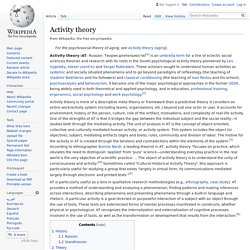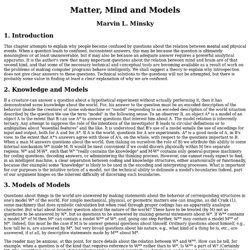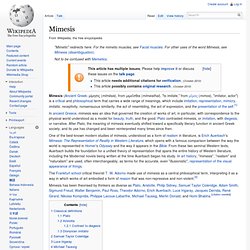

Activity theory. Activity theory (AT; Russian: Теория деятельности)[1] is an umbrella term for a line of eclectic social sciences theories and research with its roots in the Soviet psychological activity theory pioneered by Lev Vygotsky, Alexei Leont'ev and Sergei Rubinstein.

These scholars sought to understand human activities as systemic and socially situated phenomena and to go beyond paradigms of reflexology (the teaching of Vladimir Bekhterev and his followers) and classical conditioning (the teaching of Ivan Pavlov and his school), psychoanalysis and behaviorism. It became one of the major psychological approaches in the former USSR, being widely used in both theoretical and applied psychology, and in education, professional training, ergonomics, social psychology and work psychology.[2] Activity theory is more of a descriptive meta-theory or framework than a predictive theory.
It considers an entire work/activity system (including teams, organizations, etc.) beyond just one actor or user. Minsky - Matter, Mind and Models. Marvin L.

Minsky 1. Introduction This chapter attempts to explain why people become confused by questions about the relation between mental and physical events. When a question leads to confused, inconsistent answers, this may be because the question is ultimately meaningless or at least unanswerable, but it may also be because an adequate answer requires a powerful analytical apparatus. 2. If a creature can answer a question about a hypothetical experiment without actually performing it, then it has demonstrated some knowledge about the world. 3.
Questions about things in the world are answered by making statements about the behavior of corresponding structures in one's model W* of the world. The reader may be anxious, at this point, for more details about the relation between W* and W**. 4. Why is this division so richly represented in language and thought? As for the genesis of such partitions, I suppose that they grow apart rather than together, on the whole. 5. 6. Mind's Self Portrait. Sorry, But Your Soul Just Died. Powered by Translate From neuroscience to Nietzsche.

A sobering look at how man may perceive himself in the future, particularly as ideas about genetic predeterminism takes the place of dying Darwinism. This article was first published in "Forbes ASAP" in 1996. Being a bit behind the curve, I had only just heard of the digital revolution last February when Louis Rossetto, cofounder of Wired magazine, wearing a shirt with no collar and his hair as long as Felix Mendelssohn's, looking every inch the young California visionary, gave a speech before the Cato Institute announcing the dawn of the twenty–first century's digital civilization. Could be. Brain imaging refers to techniques for watching the human brain as it functions, in real time. Minskys Mind, Matter and Models.
Mimesis. In ancient Greece, mimesis was an idea that governed the creation of works of art, in particular, with correspondence to the physical world understood as a model for beauty, truth, and the good.

Plato contrasted mimesis, or imitation, with diegesis, or narrative. After Plato, the meaning of mimesis eventually shifted toward a specifically literary function in ancient Greek society, and its use has changed and been reinterpreted many times since then. The Frankfurt school critical theorist T. W. Semiotics for Beginners by Daniel Chandler. Petri net. A Petri net (also known as a place/transition net or P/T net) is one of several mathematical modeling languages for the description of distributed systems.

A Petri net is a directed bipartite graph, in which the nodes represent transitions (i.e. events that may occur, signified by bars) and places (i.e. conditions, signified by circles). The directed arcs describe which places are pre- and/or postconditions for which transitions (signified by arrows). Some sources[1] state that Petri nets were invented in August 1939 by Carl Adam Petri — at the age of 13 — for the purpose of describing chemical processes. Like industry standards such as UML activity diagrams, BPMN and EPCs, Petri nets offer a graphical notation for stepwise processes that include choice, iteration, and concurrent execution. Unlike these standards, Petri nets have an exact mathematical definition of their execution semantics, with a well-developed mathematical theory for process analysis.
Caminao's Ways. Concrete Syntax Matters.